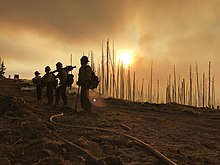
Well, here we are again! Thanks to the vagaries of the fortnightly schedule, I can already tell next issue's is going to be a bit overpacked with featured articles since five were promoted the day after the cutoff.
Other than that... well, remember this guy?
He's been keeping me from seeing my father for three years. Finally saw him at the start of this month, which I'm exceedingly happy about. Since he lives in picturesque Arizona, probably going to have a gallery in this issue or the next. He actually has a connection to our first featured article, by the way: He worked for the University of Arizona designing mounts for a good proportion of the giant telescopes that have come out in the last few decades, and I remember him telling me about the danger to Mount Graham International Observatory.
Featured articles
Seven featured articles were promoted this period.

- Frye Fire, nominated by Vami_IV
- The Frye Fire was a wildfire that burned 48,443 acres (19,604 ha) in Graham County, Arizona, United States, from June 7 to September 1, 2017. The fire was ignited by a lightning strike on Mount Graham, within the Coronado National Forest, and spread rapidly until it was mostly contained on July 12. The Frye Fire destroyed three buildings, briefly threatened the Mount Graham International Observatory, cost $26,000,000 to contain and suppress, and involved more than 800 firefighters. There were no fatalities, but 63 firefighters were quarantined as a result of a strep throat outbreak.
- Tara Lipinski, nominated by Christine (a.k.a. Figureskatingfan)
- Tara Kristen Lipinski (born June 10, 1982) is an American former competitive figure skater, actress, sports commentator, and documentary film producer. A former competitor in women's singles, she is the 1998 Olympic champion, the 1997 World champion, a two-time Champions Series Final champion (1997–1998) and the 1997 U.S. national champion. She won every competition she entered during her professional career. Until 2019, she was the youngest single skater to win a U.S. Nationals and the youngest to become an Olympic and World champion in figure skating history. She is the first woman to complete a triple loop-triple loop combination, her signature jump element, in competition. Starting in 1997, Lipinski had a rivalry with fellow skater Michelle Kwan, which was played up by the American press, and culminated when Lipinski won the gold medal at the 1998 Olympics, after which she retired from competitive figure skating. Lipinski, along with sports commentator Terry Gannon and fellow figure skater and good friend Johnny Weir, became NBC's primary figure skating commentators in 2014.
- Alan Rawlinson, nominated by Ian Rose
- Alan Charles Rawlinson, OBE, DFC & Bar, AFC (31 July 1918 – 27 August 2007) was an Australian airman who became a fighter ace in World War II. He was credited with at least eight aerial victories, as well as two aircraft probably destroyed, and another eight damaged.
- Born in Fremantle, Western Australia, Rawlinson joined the Royal Australian Air Force (RAAF) in 1938. He was posted to the Middle East in July 1940 and saw action with No. 3 (Army Cooperation) Squadron. Twice credited with shooting down three enemy aircraft in a single sortie, he was awarded the Distinguished Flying Cross (DFC) in October 1941 and took command of No. 3 Squadron the next month. He returned to Australia in March 1942, but was posted to the South West Pacific as the inaugural commanding officer of No. 79 Squadron in May 1943, flying Supermarine Spitfires in New Guinea. After serving as commanding officer of the RAAF's Paratroop Training Unit at Richmond, New South Wales, he returned to the Pacific to command No. 78 (Fighter) Wing, and held command of No. 78 Wing until his discharge from the RAAF in December 1946.
- Rawlinson was commissioned into the Royal Air Force (RAF) in March 1947. He flew de Havilland Vampire jet fighters as commanding officer of No. 54 Squadron in 1949, and then as commander of flying operations at RAF Odiham from 1949 to 1952. He was awarded the Air Force Cross in June 1952. Between 1953 and 1958 he was in charge of the RAF's Guided Weapons Trials Unit in the UK and Australia. Appointed an Officer of the Order of the British Empire in June 1958, he commanded RAF Buchan in 1960–61 before retiring from the military to live in South Australia.
- La Salute è in voi!, nominated by Czar
- La Salute è in voi! was an early 1900s bomb-making handbook associated with the Galleanisti, followers of anarchist Luigi Galleani, particularly in the United States. Translated as "Health Is in You!" or "Salvation Is within You!", its anonymous authors advocated for impoverished workers to overcome their despair and commit to individual, revolutionary acts. The Italian-language handbook offered plain directions to give non-technical amateurs the means to build explosives. Though this technical content was already available in encyclopedias, applied chemistry books, and industrial sources, La Salute è in voi wrapped this content within a political manifesto. Its contents included a glossary, basic chemistry training, and safety procedures. Its authors were likely Galleani and his friend Ettore Molinari, a chemist and anarchist. American police and historians would use the handbook to profile anarchists and imply guilt by possession. A decade after its release, La Salute è in voi! figured prominently in the prosecution of the 1915 Bresci Circle failed bombing of New York City's St. Patrick's Cathedral, in which the case revolved around the anarchists' right to read.
- The Holocaust in Bohemia and Moravia, nominated by buidhe
- The Holocaust in Bohemia and Moravia resulted in the deportation, dispossession, and murder of most of the pre-World War II population of Jews in the Czech lands that were annexed by Nazi Germany between 1939 and 1945.
- Before the Holocaust, the Jews of Bohemia were among the most assimilated and integrated Jewish communities in Europe; antisemitic prejudice was less pronounced than elsewhere on the continent. The first anti-Jewish laws in Czechoslovakia were imposed following the 1938 Munich Agreement and the German occupation of the Sudetenland. In March 1939, Germany invaded and partially annexed the rest of the Czech lands as the Protectorate of Bohemia and Moravia. More anti-Jewish measures followed, imposed mainly by the Protectorate administration (which included both German and Czech officials). Jews were stripped of their employment and property, required to perform forced labor, and subject to discriminatory regulations including, in September 1941, the requirement to wear a yellow star. Many were evicted from their homes and concentrated into substandard housing. Some 30,000 Jews, from the pre-invasion population of 118,310, managed to emigrate. Most of the remaining Jews were deported to other Nazi-controlled territories, starting in October 1939 as part of the Nisko plan. In October 1941, mass deportations of Protectorate Jews began, initially to Łódź Ghetto. Beginning in November 1941, the transports departed for Theresienstadt Ghetto in the Protectorate, which was, for most, a temporary stopping-point before deportation to other ghettos, extermination camps, and other killing sites farther east. By mid-1943, most of the Jews remaining in the Protectorate were in mixed marriages and therefore exempt from deportation.
- About 80,000 Jews from Bohemia and Moravia were murdered in the Holocaust. After the war, surviving Jews—especially those who had identified as Germans before the war—faced obstacles in regaining their property and pressure to assimilate into the Czech majority. Most Jews emigrated; a few were deported as part of the expulsion of Germans from Czechoslovakia. The memory of the Holocaust was suppressed in Communist Czechoslovakia, but resurfaced in public discourse after the fall of the Iron Curtain in 1989.
- Theodosius III, nominated by Iazyges
- Theodosius III (Greek: Θεοδόσιος, romanized: Theodósios) was Byzantine emperor from c. May 715 to 25 March 717. Before rising to power and seizing the throne of the Byzantine Empire, he was a tax collector in Adramyttium. In 715, the Byzantine navy and the troops of the Opsician Theme, one of the Byzantine provinces, revolted against Emperor Anastasius II (r. 713–715), acclaiming the reluctant Theodosius as emperor. Theodosius led his troops to Chrysopolis and then Constantinople, the capital, seizing the city in November 715. Anastasius did not surrender until several months later, accepting exile in a monastery in return for safety. Many themes viewed Theodosius to be a puppet of the troops of the Opsician Theme, and his legitimacy was denied by the Anatolics and the Armeniacs under their respective strategoi (generals) Leo the Isaurian and Artabasdos.
- Leo declared himself emperor in the summer of 716 and allied himself with the Islamic empire of the Umayyad Caliphate. Leo then marched his troops to Constantinople, seizing the city of Nicomedia, and capturing many officials, including Theodosius' son, also named Theodosius. With his son in captivity, Theodosius negotiated with Leo, agreeing to abdicate and recognize Leo as emperor. Leo entered Constantinople and definitively seized power on 25 March 717, allowing Theodosius and his son to retire to a monastery. Exactly when Theodosius died is uncertain, but it may have been on 24 July 754.
- Alexis Soyer, nominated by Tim riley
- Alexis Benoît Soyer (4 February 1810 – 5 August 1858) was a French chef, writer and inventor, who made his reputation in Victorian England.
- Born in north-east France, Soyer trained as a chef in Paris, and quickly built a career that was brought to a halt by the July Revolution of 1830. Moving to England he worked in the kitchens of royalty, the aristocracy and the landed gentry until 1837. He was then appointed head chef of the Reform Club in London, where he designed the kitchens on radical modern lines and became celebrated for the range and excellence of his cooking. His best-known dish, lamb cutlets Reform, has remained on the club's menu since the 1840s and has been taken up by later chefs from Auguste Escoffier to Prue Leith.
- Soyer became a well-known author of cookery books. He took a keen interest in public health, and when the Irish potato famine struck in the 1840s he went to Dublin and set up a soup kitchen that could feed 1,000 people an hour; he published recipes for inexpensive and nutritious food and developed cheaper alternatives to bread.
- During the Crimean War, reports reached London of the appalling privations endured by British soldiers, with disease rife and food inadequate. At the request of the British government Soyer travelled to the Crimea in 1855 and worked with the nursing pioneer Florence Nightingale to improve conditions for the troops. He ensured that in all parts of the army there were nominated cooks, useful recipes, and the means to cook food properly − in particular, the portable Soyer stove which he invented and which remained in army use, with modifications, for more than a century. In the Crimea, Soyer became seriously ill; he never fully recovered his health. A little over a year after his return to London in 1857 he died of a stroke.
Featured pictures
Eight featured pictures were promoted this period, including those at the top and bottom of this article.
-
Roosilawaty by Tati Photo Studio, Jakarta; restored by Chris Woodrich
-
Banz Abbey by Ermell
Featured lists
Four featured lists were promoted this period.

- List of Music Bank Chart winners (2015), nominated by EN-Jungwon and Jal11497
- The Music Bank Chart is a record chart established in 1998 on the South Korean KBS television music program Music Bank. Every week during its live broadcast, the show gives an award for the best-performing single on the South Korean chart.
- Lodestar Award for Best Young Adult Book, nominated by PresN
- The Lodestar Award for Best Young Adult Book is an award given annually to a book published for young adult readers in the field of science fiction or fantasy. The name of the award was chosen because a lodestar is "a star that guides or leads, especially in navigation, where it is the sole reliable source of light—the star that leads those in uncharted waters to safety." The nomination and selection process is administered by the World Science Fiction Society (WSFS), and the award is presented at the Hugo Award ceremony at the annual World Science Fiction Convention, or Worldcon, although it is not itself a Hugo Award.
- Arsenal Player of the Season, nominated by Idiosincrático
- The Arsenal Player of the Season award is an official award given by Arsenal Football Club to the best performing player from the club over the course of the season. The award is given based on votes by Arsenal fans on the club's website, and was previously based on votes by the Arsenal Supporters' Trust.
- List of accolades received by Guardians of the Galaxy (film), nominated by Chompy Ace
- Guardians of the Galaxy is a 2014 American superhero film based on the Marvel Comics superhero team of the same name. Produced by Marvel Studios and distributed by Walt Disney Studios Motion Pictures, it is the 10th film in the Marvel Cinematic Universe (MCU). Directed by James Gunn, who wrote the screenplay with Nicole Perlman, the film features an ensemble cast including Chris Pratt, Zoe Saldaña, Dave Bautista, Vin Diesel, and Bradley Cooper as the titular Guardians, a group of extraterrestrial criminals go on the run after stealing a powerful artifact. The film has received various awards and nominations.
-
Sunrise at Sugarloaf Mountain by Donatas Dabravolskas, another of our featured pictures.










Discuss this story
Just out of curiosity, after anthropomorphized COVID, did anyone else read the rest of the paragraph (permalink) with "he" referring to COVID rather than the author's father? Anomie⚔ 13:28, 9 March 2023 (UTC)[reply]